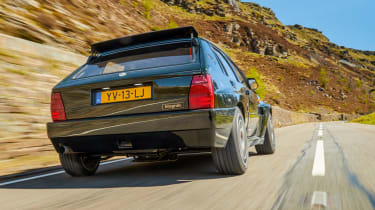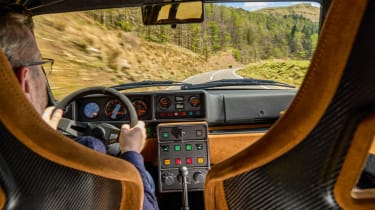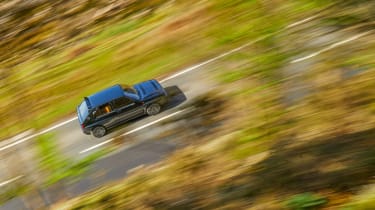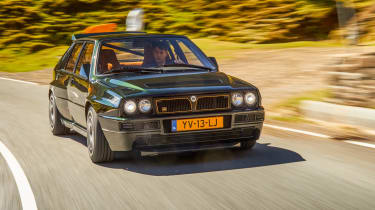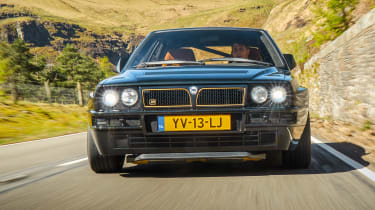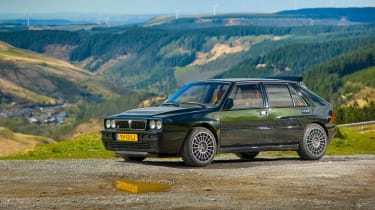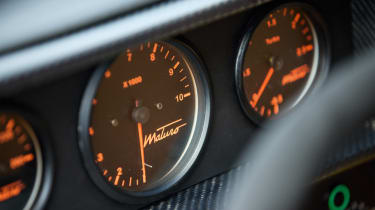Maturo Stradale 2023 review – Lancia's Delta Integrale reimagined
The Dutch-built Lancia Delta Integrale restomod lands in the UK for some tough road-test miles – and feels immediately at home
Photographer Matt Howell takes a step back, which is unusual for him, and hard to do because he’s standing against a wall. For a moment I wonder if he’s lost his footing but the look on his face says not. I understand his concern later when I see the shot in the back of his camera: the Integrale heading towards him had clear air under its right-hand wheels.
Thing is, from the driver’s seat I had no sensation of anything dramatic happening. I chose this bit of road because it is almost stepped by subsidence and I thought the car might look good compressed into it. The really curious bit was that the faster the Integrale hit the bump, the smoother it felt. In the final shot it was pulling hard in third gear.
> New 2023 Subaru WRX review: the Impreza's spiritual successor
That’s rally cars for you, and make no mistake, it may be painted dark metallic green and have a stylish, fully trimmed interior, but mechanically this is pretty much a fully-fledged rally car. It’s called the Stradale and it’s the work of Dutch Lancia specialist Maturo, builder of rally cars and restorer of Integrales, who we featured in issue 308. As the Stradale name suggests, this is a road-spec version of the company’s Group A Delta Integrale recreation, but it’s quite a bit more exotic because it has body panels fashioned from carbonfibre. It causes quite a stir wherever it goes.
More reviews
Group tests
- Alpine A290 v Alpine A110 – how much DNA do they really share?
- Ariel Atom 4R v Caterham Seven ‘evo25’: power-to-weight heroes go head-to-head
- Aston Martin Vantage vs Audi R8 V10 RWD – back to basics
- Caterham Super Seven 600 v Super Seven 2000
- Levante v T1
- Corvette Stingray v Porsche Cayman GTS v Audi R8 RWD
- Great Ferrari hypercars driven: 288 GTO, F40, F50 and Enzo head-to-head
- Lamborghini Aventador Ultimae v Lamborghini Countach
- Lotus Emira v Morgan Plus Four – four-cylinder Brits go head-to-head
- Toyota GR86 v BBR Mazda MX-5: supercharged drop-top battles sports coupe
In-depth reviews
- Abarth 600e 2025 review – Italy gives the Alpine A290 something to worry about
- Alpine A110 review – distinctive, lightweight and unforgettable to drive
- Audi RS7 Sportback Performance review
- Bentley Continental R Mulliner: review, history and specs
- BMW 5-series review – is this still Munich’s anchor model?
- BMW 1-series review – Munich’s Audi A3 rival gains focus
Long term tests
- Abarth 695C Turismo Fast Fleet test – 10,000 miles in the Italian hot hatch
- Alfa Romeo Giulia Veloce Fast Fleet test – 7000 miles in the sharp Italian saloon
- Alpina B10: end of term report
- Alpina B10
- Ford Mustang GT
- Ford Mustang GT
- Ford Mustang GT
- Land Rover Defender 110 Fast Fleet test – 9000 miles in the go-anywhere SUV
- Maserati Ghibli Trofeo Fast Fleet test – 4000 miles in the Ferrari-powered saloon
- Mitsubishi Evo MR 340
Review
- New Aston Martin DBS 770 Ultimate review – 759bhp super-GT driven
- New Bentley Batur 2023 review – can it possibly be worth £1.65m?
- 2023 Chevrolet Corvette C8 Z06 review – the American 911 GT3?
- Kia EV6 GT-Line S prototype review – the EV that shows how it’s done
- BBR Supercharged Mazda MX-5 (ND) 2023 review – tuned 250bhp roadster driven
- MG4 Trophy 2023 review
Reviews
- Abarth 695 75 Anniversario edition 2024 review – a fitting send-off for Abarth’s hot supermini?
- Abarth 500e 2023 review
- AC Cobra 378 Superblower MkIV 2021 review – another V8 Cobra, but with a GM heart this time
- Acura Integra Type S 2024 review – a Honda Civic Type R with added restraint
- Alfa Romeo Giulia 2025 review – get one while you still can
- Alfa Romeo SZ: history, review and specs of an icon
- Alfa Romeo 1750 TBi
- Alpina B3 GT Touring 2025 review – a 190mph alternative to the BMW M3 Touring
We rendezvoused earlier at the marvellous Bwlch Mountain viewpoint in south Wales on a glorious, bright morning. Zion Geeratz, project manager of the Stradale, hopped from a period-correct, Martini-liveried van and looked around, a big smile on his face. ‘This is the natural environment for our car,’ he said.
Topographically speaking it’s certainly more interesting and challenging than Veghel, north of Eindhoven in the Netherlands, where Maturo is based. Geeratz doesn’t just mean these Welsh hills, though; a couple of days earlier the car was on display at the Bicester Scramble. ‘The response to the car was fantastic,’ he says. ‘People recognised that it was not standard and were so enthusiastic.’ I’m not at all surprised. Basking in the sunlight, its paintwork glittering, the Stradale looks fabulous.
This popular viewpoint is already getting busy and a few people have wandered over, asking politely if they can take pictures. There’s such an affection for the Integrale, it’s such an iconic car, yet quite a rare sight these days. A van has turned up selling hot drinks and snacks and it turns out the old fella running it used to rally one: ‘Best car I ever had. Should never have sold it…’
The Stradale looks tight, sharp and subtly different from standard. The more time you spend with it, the more you spot. Instead of the HF badge, the grille wears the signature ‘M’ of Maturo. Cleverly, the aluminium supports for the jacked-up tailgate spoiler are Ms too, while the rear is cleaned up quite a bit, but you’d probably need a standard car next to it to spot the differences. I love that there’s still just a single, stock-size tailpipe sprouting from beneath the rear apron, even though there’s 350bhp up front. The iconic wheels hint at the rally-spec hardware behind them, as they’re a four-bolt pattern. Oddly, the rally cars had four lugs and the road cars had five.
The diagonal beam gives away the fact that there’s a cage, but it’s a surprise to discover that it’s a full cage. Step over the door bar, settle into the high-back seat, look up, and you’ll see cruciforms neatly tucked into the roof space front and rear. (The cross beam can be unbolted so the rear seats can be used.) It’s so neatly integrated, at quite some effort and expense; the front legs pass through the tops of the air vents at either end of the dashboard and so the vents have been remade in diecast aluminium to accommodate the tubes.
The cage is an essential part of the package. The shell of the donor car is stripped back to bare metal, made good and then strengthened in known weak spots. This is the same process for Maturo’s straightforward Integrale restorations. For the Stradale, a full cage is built in, adding considerable strength, and all the outer panels are removed and replaced with carbonfibre replicas. They took two years to develop but they not only reduce the car’s weight by 50kg, they also fit better and add stiffness, being bonded to the shell with aircraft-standard adhesive. Sometimes, when the light catches the doors just so, you can see the weave.
There’s plenty of carbonfibre on the inside, too. It’s used for the door casings, seat shells and also the lower shelf of the dashboard, contrasting the light and dark Alcantara of the fully trimmed, high-quality cockpit. As a fan of the original instrument pack, which is crammed with dials with yellow markings, the Stradale’s thrifted set looks a bit gappy but follows the pattern set by the Group A rally cars, with a 10k rev counter centre stage and a smaller speedo left and boost gauge right. The centre of the facia carries the rest of the readouts and switches, including a button marked ‘Juha’. This selects the feistiest delivery and stiffens the dampers and is named in honour of rally legend, Delta ace and friend of Maturo, Juha Kankkunen.
As on the outside, it’s the details that impress. The horn push carries an embossed M, there’s a small, bronze ‘Maturo’ badge on the glovebox, and even the rotary controls for the heating and ventilation have been remade in aluminium. The only original parts, it seems, are the cheap-feeling, scratchy plastic stalks. Even the toggle for the electrical cut-out switch – which would normally be red plastic – is black and cool to the touch because it’s a bespoke metal item, which means it also carries the M. Twist it to on, flick the fuel switch, dip the clutch and press the start button.
The transverse, 2-litre Lampredi engine clatters into life like a proper, authentic rally-car motor, loud but not abrasively so, with that distinctive, twin-cam, four-cylinder beat – slightly hollow, cammy and a bit fruity. The gearshift is all new and rally style – a 10-inch aluminium lever topped by a ball so that it’s closer to the wheel than the stumpy original shifter. At its base it attaches to a large ball joint mounted in a plinth, and beneath that is the rod that takes the shift action to the gearbox. Aft of the shifter is a nicely engineered, fly-off, hydraulic handbrake.
This is the prototype car and now it’s racked up some miles there are a few things Maturo wants to change. The first is the clutch, which is quite a challenge, with an abrupt bite and grabby character. There’s quite a lot of mechanical feedback from the front end, too, much of it the huffing and chuffing of the turbocharger, which I’m here for, but there’s a fair bit of simple mechanical thrash that doesn’t add to the experience. Geeratz is already lining up more bulkhead sound deadening and a new spec of clutch.
Boost builds very quickly in first gear, but once you’re into second you appreciate that it’s a well-mannered engine, beautifully smooth on and off the throttle. It pulls well even off boost, so while it’s very obviously turbocharged – coming on boost strongly and with much whoosh and chatter from beneath the bonnet – once on boost it’s not a flash in the pan but solid power delivered over quite a wide rev band. This allows you to deploy power and torque almost like a regular throttle and work the chassis with satisfying precision.
The ride initially feels quite robust, so when you see a big bump coming you tense slightly… only to discover the suspension has a good amount of give in it. It’s sporty but has an almost surreal ability to absorb bumps, just like a rally car would. I should have had faith; I got to drive the Stradale briefly when we visited the Maturo factory, and Marco Geeratz, Zion’s father and co-founder of the company, was keen to demonstrate just how capable its suspension was. This involved him driving their Martini-liveried, Group A Delta rally car at a local speed hump at, er, speed, with me keeping up behind in the Stradale. It was ridiculously impressive; the sting was taken out of the initial impact and the landing was so soft, so sweet, you’d never guess all four wheels were off the ground… That’s why when I saw the gnarly-looking bit of Welsh subsidence, I suggested it to Matt as a photo opportunity.
There’s a huge variety of surfaces and corners here and unsurprisingly the Stradale feels like it has come home. Some readers might think this heresy but I’ve never been a massive fan of the standard Integrale’s dynamics. I road tested a couple of them when they were new and I found them a bit dull because they didn’t exploit their four-wheel drive. They were more Golf-with-Haldex than Impreza, if you like. So if you’d asked me before I’d driven the Stradale here in Wales which was the more appealing, the P25 – Prodrive’s new carbon-bodied Impreza – or the Maturo Integrale, I’d have said the Impreza. Now I’m not so sure.
The Stradale doesn’t seem to put a wheel wrong. Once you’re rolling you quickly get into an easy, natural flow. You can rely on the car’s composure and carry loads of speed, while traction is outstanding. The drivetrain isn’t just more robust, it’s enhanced with a limited-slip diff at the front to match the one in the rear. There’s a bit of adjustability on offer and loads of grip, and that’s on Michelin Pilot Sport 4 Ss. Normally, the Stradale would be on Cup 2s but, having looked at typical Welsh weather, Zion decided not to take the risk.
The only thing you have to get used to is the brakes, which are unservoed and so need a good push, but are easy to modulate and well up to the task. Then, the further and harder you go, the more absorbing it becomes thanks to the positive steering and the seemingly unbreachable grip. Clamped into place by the superb bucket seat, you calmly direct the car’s confident progress down the road. As a matter of course, during shell prep Maturo lowers the seat by a couple of inches, which improves the geometry of the driving position, but you still have a great view down the road to pick lines.
Into corners the grip is phenomenal, while traction on the exit is total, so you get on the throttle earlier and earlier and the speed keeps climbing. The limit seems to be your nerve. And then, being ridiculously greedy with the throttle in a tighter turn, the nose nudges wide. Finally! I can only think it must be mind-blowing on warm asphalt on Cup 2s, like being on a tarmac rally. I’m surprised the options don’t include a co-driver on pace notes. They could do more than just call the corners, too; you can adjust the damping on the fly, via a pair of dashboard switches, one for the front axle, one for the rear. The scale is from 1 to 10 and the scope is enough to give the suppleness to neutralise a notoriously lumpen road that wrong-foots so many cars we bring here, and then sharpen it up in a moment for firm control on the following smooth, fast stretch with its irregular, tight and technical sections. You could use the dampers to tweak the handling balance too, setting the rear to stiff in the wet to minimise understeer.
The Stradale is beautifully made, fabulously detailed and goes brilliantly, but a key part of its appeal is the reassurance that it is based on a proven mechanical package. The engine and gearbox, drivetrain and suspension have all been developed for rallying by Maturo over many years, in its crusade to engineer out the Delta’s many weaknesses, so that it can build and sell its clients a better-than-original, authentic-spec, historic Group A Delta rally car that won’t let them down or bankrupt them.
You’d think that a car which dominated Group A, winning the World Rally Championship six years on the bounce, would have achieved that by being robust. In fact, Lancia-Martini had such a massive budget they didn’t need to make the cars super-durable, they simply threw new parts at them at every service and sold the cars off after each rally, starting the next one with fresh cars. Colin Chapman said the perfect race car would fall apart when it crossed the line, meaning nothing was wasted in terms of weight or durability, and it seems that Lancia-Martini had a similar approach to rallying the Delta. It isn’t a business model that would work for Maturo, which is why it now has an inventory of 2500 parts it has developed to ensure reliability and durability, from which the Stradale benefits.
In that vein, there are further areas where this prototype car is a work in progress. Maturo has a new gearbox in development. It’s a stronger dog ’box but one with helical gears, so it will be as quiet as a regular ’box while allowing the car to deliver the intended 400bhp. It will be an option for its rally replica too. Further sound deadening to make it more habitable in everyday driving will be joined by door mirrors that work; the current little aerodynamic pods look great but are quite useless.
Among the options already offered are a sound system and air conditioning, and a ‘Sainz’ steering rack. When the Spaniard drove a Delta for the Repsol team they developed a faster steering rack for sharper response, and Stradale customers can have one too. The car works fine as it is but in tight and twisty stuff it can feel just a bit slow-witted. Another interesting option is suspension that offers ride height adjustment on the move, and there’s also talk of a turbocharged and supercharged version of the Lampredi engine with a sequential gearbox.
Having invested a substantial amount of time and money into building the first Stradale, Geeratz joked that either they’d have a business or they’d bankrupt themselves but have a very nice car. Well, they have both; even though each Stradale will cost £400k-plus, including the donor car and local taxes, in just the last couple of months they have been commissioned to build five, with three more orders pending. Each will take six months to craft, which will keep them busy. And in case they’re not busy enough, in a few months they will complete their first conversion of a Lancia Beta Monte Carlo into a rally-spec 037…
Maturo Stradale specs
| Engine | In-line 4-cyl, 1995cc, turbocharged |
| Power | 400bhp @ 5500bhp |
| Torque | 369lb ft @ 3500-6000rpm |
| Weight | 1190kg (342bhp/ton) |
| 0-62mph | c4.0sec (est) |
| Top speed | 171mph |
| Basic price | c£400,000 |
This story was first featured in evo issue 311.

